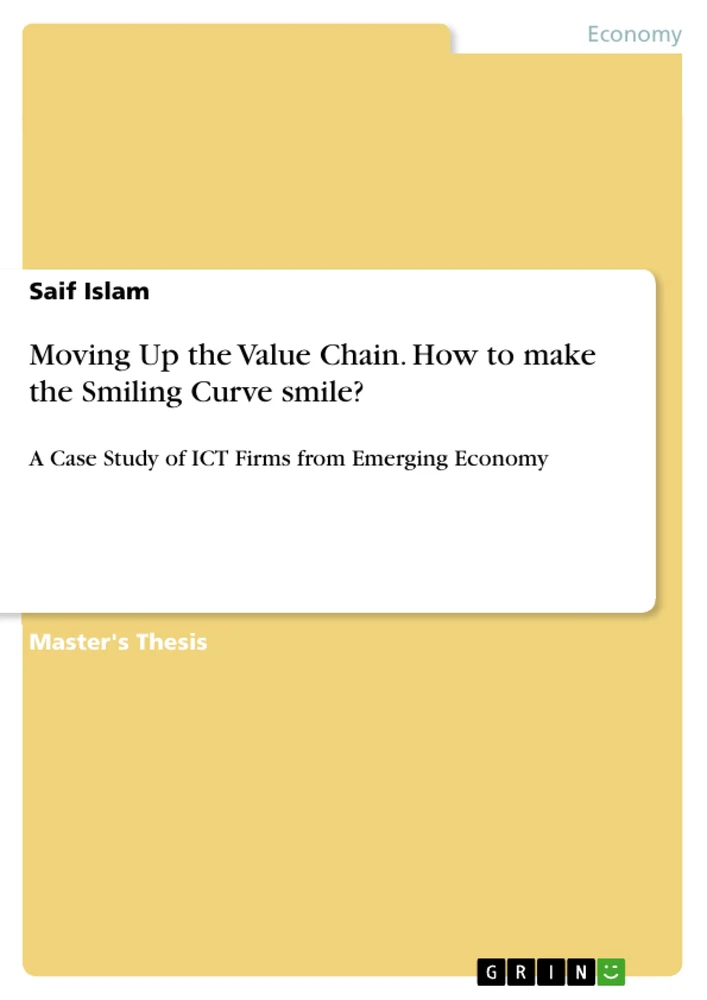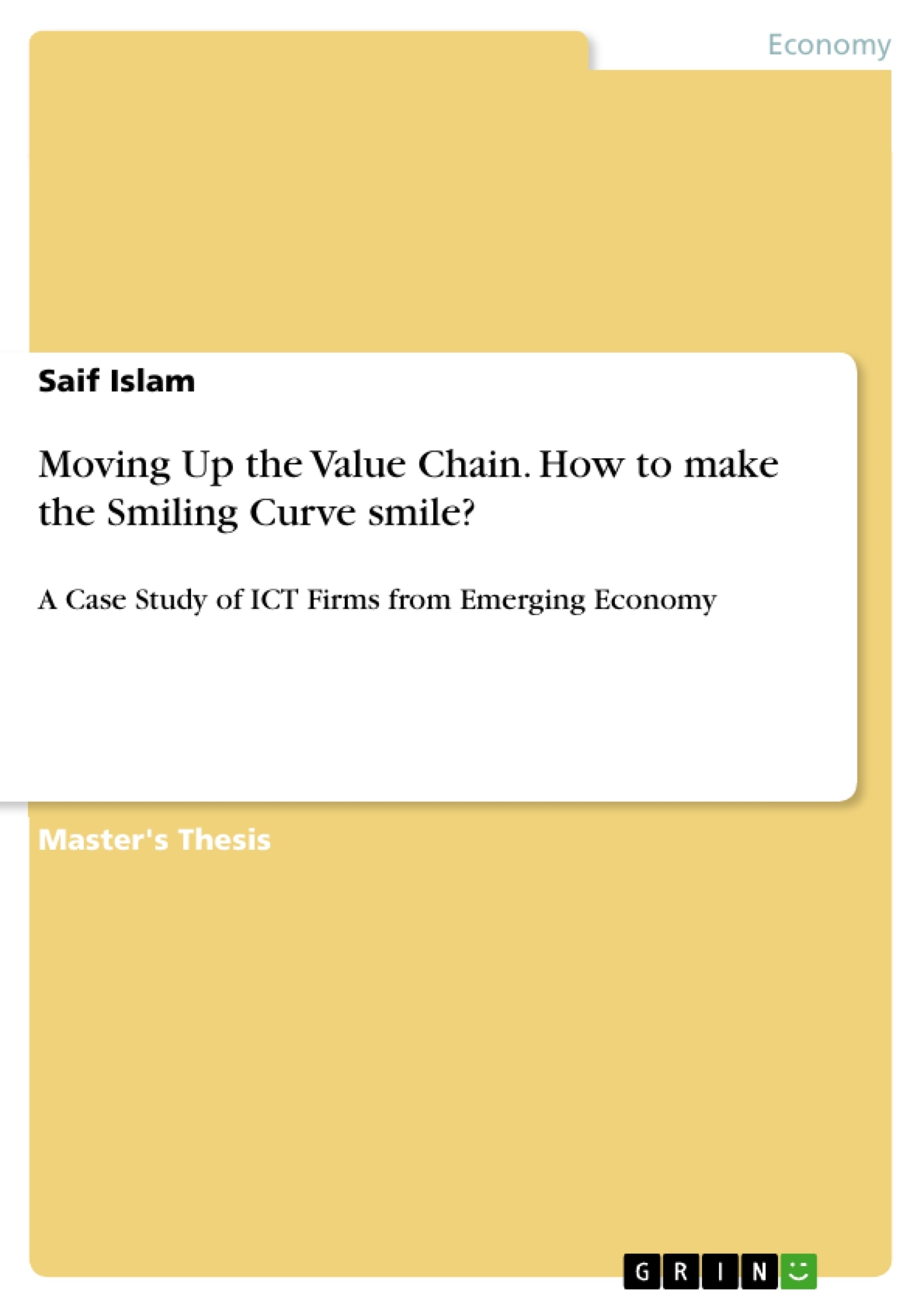
Moving Up the Value Chain. How to make the Smiling Curve smile?
Masterarbeit, 2011
50 Seiten, Note: Pass with highest distinction
Leseprobe
Table of Contents
- 1. Introduction
- 1.1 Background
- 1.2 Problem Formulation
- 1.3 Research Purpose
- 1.4 Research Scope and Delimitations
- 1.5 Thesis Deposition
- 2. Conceptual Framework
- 2.1 Global Value Chain (GVC) Upgrading Theory
- 2.2 Industrial Organization (IO) Theory
- 2.3 Resource-Based Theory
- 2.4 Conceptual Model
- 3. Methodology
- 3.1 Choice of Literature
- 3.2 Research Approach
- 3.3 Research Design
- 3.3.1 Research Process
- 3.3.2 Case Selection
- 3.3.3 Data Collection
- 4. Empirical Evidence
- 4.1 Foxconn
- 4.2 Acer
- 4.3 HTC
- 4.4 Summary of Case Companies
- 5. Analysis
- 5.1 Global Value Chain and Latecomer Upgrading
- 5.1.1 Is Upgrading an Incremental Process?
- 5.1.2 Acquiring Upgrading Know-How
- 5.2 Functional Upgrading – from Imitation to Innovation
- 5.2.1 Product and Process Innovation
- 5.2.2 Innovation Forecast
- 5.3 Market Creation
- 5.3.1 New Product Standards
- 5.3.2 New Market Segments
- 5.4 Revised Conceptual Model
- 5.5 Limitations of the Conceptual Model
Objectives and Key Themes
This master's thesis aims to investigate how ICT firms from emerging economies can move up the value chain, addressing the challenge of escaping low-value-added manufacturing. The study utilizes case studies of Taiwanese ICT firms to develop a conceptual model explaining this upward mobility.
- The "Smiling Curve" phenomenon and its implications for emerging economies.
- Strategies for value chain upgrading in the ICT sector.
- The role of product and process innovation in achieving upward mobility.
- The creation of new markets as a means of value chain upgrading.
- Development and limitations of a conceptual model for value chain upgrading.
Chapter Summaries
1. Introduction: This introductory chapter sets the stage for the thesis by presenting the background on the "Smiling Curve" concept, highlighting the challenges faced by firms from emerging economies in climbing the value chain within the ICT sector. It clearly defines the research problem—understanding how firms from emerging economies successfully move up the value chain—and outlines the research purpose, scope, and limitations. The chapter lays the groundwork for the subsequent exploration of theoretical frameworks and empirical evidence.
2. Conceptual Framework: This chapter establishes the theoretical foundation for the research by exploring relevant theories, including Global Value Chain (GVC) upgrading theory, Industrial Organization (IO) theory, and Resource-Based View (RBV). It synthesizes these perspectives to propose a conceptual model explaining how firms from emerging economies can upgrade their position in the value chain. The model serves as a lens through which the subsequent case studies will be analyzed.
3. Methodology: This chapter details the research approach and design employed in the study. It explains the selection of literature, the rationale behind choosing a case study approach, and the specific methods utilized for case selection and data collection. This section provides transparency and justification for the methodology used to collect and analyze data for the case studies presented in Chapter 4.
4. Empirical Evidence: This chapter presents detailed case studies of three Taiwanese ICT firms: Foxconn, Acer, and HTC. Each case study provides empirical evidence of how these firms navigated the challenges and opportunities presented by the ICT market, showcasing different strategies for value chain upgrading. The chapter builds a strong empirical foundation for the analysis in Chapter 5.
5. Analysis: This chapter analyzes the empirical evidence presented in Chapter 4 through the lens of the conceptual model developed in Chapter 2. It explores the key themes of global value chain upgrading, functional upgrading through innovation, and market creation. The analysis deepens our understanding of the process of value chain upgrading by examining the specific experiences of the case study firms, leading to a revised conceptual model and a discussion of its limitations.
Keywords
Smiling Curve, value chain upgrading, product innovation, market creation, ICT firms, emerging economies, Taiwan, case studies, functional upgrading, latecomer advantage.
Frequently Asked Questions: Master's Thesis on Value Chain Upgrading of ICT Firms from Emerging Economies
What is the main topic of this master's thesis?
This master's thesis investigates how Information and Communications Technology (ICT) firms from emerging economies can successfully move up the value chain, escaping low-value-added manufacturing. It focuses specifically on Taiwanese ICT firms as case studies.
What is the research methodology used in this thesis?
The thesis employs a case study approach, analyzing three Taiwanese ICT firms: Foxconn, Acer, and HTC. The research design includes a literature review, case selection based on relevant criteria, and data collection through methods appropriate to the case studies. The findings are analyzed through the lens of established theoretical frameworks.
What theoretical frameworks are used in this thesis?
The thesis draws upon several theoretical frameworks including Global Value Chain (GVC) upgrading theory, Industrial Organization (IO) theory, and Resource-Based View (RBV). These theories are synthesized to create a conceptual model explaining value chain upgrading in the context of emerging economies.
What are the key themes explored in this thesis?
Key themes include the "Smiling Curve" phenomenon, strategies for value chain upgrading in the ICT sector, the role of product and process innovation, market creation as a means of upgrading, and the development and limitations of a conceptual model for value chain upgrading.
What are the key findings of the case studies?
The case studies of Foxconn, Acer, and HTC provide empirical evidence of different strategies employed by Taiwanese ICT firms to achieve value chain upgrading. The analysis explores how these firms overcame challenges and exploited opportunities in the ICT market, contributing to a deeper understanding of the upgrading process.
How does the thesis contribute to the understanding of value chain upgrading?
The thesis contributes by developing and refining a conceptual model for value chain upgrading based on the empirical findings. It examines the incremental nature of upgrading, the acquisition of upgrading know-how, and the role of functional upgrading (from imitation to innovation) and market creation. The limitations of the model are also discussed.
What are the chapter summaries of the thesis?
The thesis is structured as follows: Chapter 1 introduces the research problem and objectives; Chapter 2 establishes the theoretical framework; Chapter 3 details the research methodology; Chapter 4 presents the case studies; and Chapter 5 analyzes the findings and revises the conceptual model, addressing its limitations.
What are the keywords associated with this thesis?
The keywords are: Smiling Curve, value chain upgrading, product innovation, market creation, ICT firms, emerging economies, Taiwan, case studies, functional upgrading, latecomer advantage.
Details
- Titel
- Moving Up the Value Chain. How to make the Smiling Curve smile?
- Untertitel
- A Case Study of ICT Firms from Emerging Economy
- Veranstaltung
- International Business - International Business and Value Creation
- Note
- Pass with highest distinction
- Autor
- Saif Islam (Autor:in)
- Erscheinungsjahr
- 2011
- Seiten
- 50
- Katalognummer
- V337697
- ISBN (eBook)
- 9783668285200
- ISBN (Buch)
- 9783668285217
- Dateigröße
- 811 KB
- Sprache
- Englisch
- Schlagworte
- emerging markets product innovation market creation value chain
- Produktsicherheit
- GRIN Publishing GmbH
- Preis (Ebook)
- US$ 20,99
- Preis (Book)
- US$ 30,99
- Arbeit zitieren
- Saif Islam (Autor:in), 2011, Moving Up the Value Chain. How to make the Smiling Curve smile?, München, Page::Imprint:: GRINVerlagOHG, https://www.diplomarbeiten24.de/document/337697
- Autor werden
- Ihre Optionen
- Vertriebskanäle
- Premium Services
- Autorenprofil
- Textarten und Formate
- Services für Verlage, Hochschulen, Unternehmen

- © GRIN Publishing GmbH.
- Alle Inhalte urheberrechtlich geschützt. Kopieren und verbreiten untersagt.
- info@grin.com
- AGB
- Open Publishing
Der GRIN Verlag hat sich seit 1998 auf die Veröffentlichung akademischer eBooks und Bücher spezialisiert. Der GRIN Verlag steht damit als erstes Unternehmen für User Generated Quality Content. Die Verlagsseiten GRIN.com, Hausarbeiten.de und Diplomarbeiten24 bieten für Hochschullehrer, Absolventen und Studenten die ideale Plattform, wissenschaftliche Texte wie Hausarbeiten, Referate, Bachelorarbeiten, Masterarbeiten, Diplomarbeiten, Dissertationen und wissenschaftliche Aufsätze einem breiten Publikum zu präsentieren.
Kostenfreie Veröffentlichung: Hausarbeit, Bachelorarbeit, Diplomarbeit, Dissertation, Masterarbeit, Interpretation oder Referat jetzt veröffentlichen!
- GRIN Verlag GmbH
-
- Nymphenburger Str. 86
- 80636
- Munich, Deutschland
- +49 89-550559-0
- +49 89-550559-10
- info@grin.com
-









